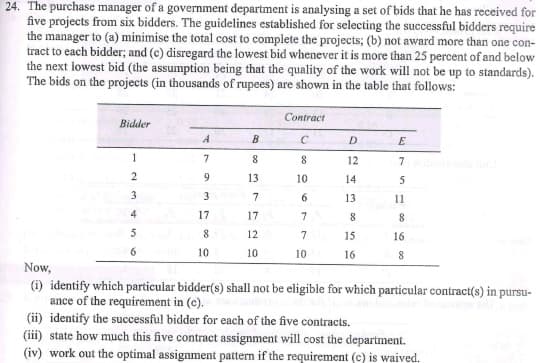24. The purchase manager of a government department is analysing a set of bids that he has received for five projects from six bidders. The guidelines established for selecting the successful bidders require the manager to (a) minimise the total cost to complete the projects; (b) not award more than one con- tract to each bidder; and (c) disregard the lowest bid whenever it is more than 25 percent of and below the next lowest bid (the assumption being that the quality of the work will not be up to standards). The bids on the projects (in thousands of rupees) are shown in the table that follows: Contract Bidder D E 1 8. 12 7 9 13 10 14 5 3. 7 6. 13 11 4 17 17 7. 8 8. 8. 12 15 16 6 10 10 10 16 8. Now, (i) identify which particular bidder(s) shall not be eligible for which particular contract(s) in pursu- ance of the requirement in (e). (ii) identify the successful bidder for each of the five contracts. (iii) state how much this five contract assignment will cost the department. (iv) work out the optimal assignment pattern if the requirement (c) is waived.
24. The purchase manager of a government department is analysing a set of bids that he has received for five projects from six bidders. The guidelines established for selecting the successful bidders require the manager to (a) minimise the total cost to complete the projects; (b) not award more than one con- tract to each bidder; and (c) disregard the lowest bid whenever it is more than 25 percent of and below the next lowest bid (the assumption being that the quality of the work will not be up to standards). The bids on the projects (in thousands of rupees) are shown in the table that follows: Contract Bidder D E 1 8. 12 7 9 13 10 14 5 3. 7 6. 13 11 4 17 17 7. 8 8. 8. 12 15 16 6 10 10 10 16 8. Now, (i) identify which particular bidder(s) shall not be eligible for which particular contract(s) in pursu- ance of the requirement in (e). (ii) identify the successful bidder for each of the five contracts. (iii) state how much this five contract assignment will cost the department. (iv) work out the optimal assignment pattern if the requirement (c) is waived.
Practical Management Science
6th Edition
ISBN:9781337406659
Author:WINSTON, Wayne L.
Publisher:WINSTON, Wayne L.
Chapter5: Network Models
Section5.5: Shortest Path Models
Problem 37P
Related questions
Question

Transcribed Image Text:24. The purchase manager of a government department is analysing a set of bids that he has received for
five projects from six bidders. The guidelines established for selecting the successful bidders require
the manager to (a) minimise the total cost to complete the projects; (b) not award more than one con-
tract to each bidder; and (c) disregard the lowest bid whenever it is more than 25 percent of and below
the next lowest bid (the assumption being that the quality of the work will not be up to standards).
The bids on the projects (in thousands of rupees) are shown in the table that follows:
Contract
Bidder
A
D
E
1
7
8
12
7
2
13
10
14
5
3
3
7
6.
13
11
4
17
17
7
8.
8
12
7
15
16
6
10
10
10
16
8
Now,
(i) identify which particular bidder(s) shall not be eligible for which particular contract(s) in pursu-
ance of the requirement in (c).
(ii) identify the successful bidder for each of the five contracts.
(iii) state how much this five contract assignment will cost the department.
(iv) work out the optimal assignment pattern if the requirement (c) is waived,
Expert Solution
This question has been solved!
Explore an expertly crafted, step-by-step solution for a thorough understanding of key concepts.
Step by step
Solved in 3 steps with 7 images

Knowledge Booster
Learn more about
Need a deep-dive on the concept behind this application? Look no further. Learn more about this topic, operations-management and related others by exploring similar questions and additional content below.Recommended textbooks for you

Practical Management Science
Operations Management
ISBN:
9781337406659
Author:
WINSTON, Wayne L.
Publisher:
Cengage,

Practical Management Science
Operations Management
ISBN:
9781337406659
Author:
WINSTON, Wayne L.
Publisher:
Cengage,